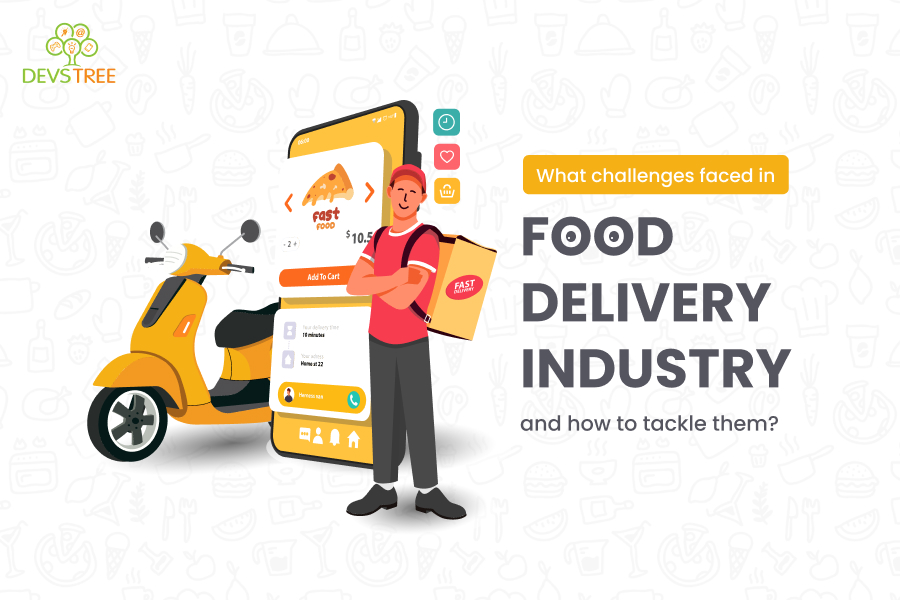
Introduction: If you are a food delivery business owner, entrepreneur, or start up founder seeking to navigate the complexities of the food delivery industry, you’ve come to the right place. In this article, we will explore the challenges faced by food delivery businesses and offer practical solutions to help you gain a competitive edge. As an experienced mobile app development company in the UK, we have built custom food delivery apps and gained valuable insights into the industry. Our goal is to share these insights to assist you in streamlining your food delivery app development.
Let’s dive into the Seven Major Challenges in the Food Delivery Business and their Corresponding Solutions.
Challenge #1 – Maintaining Customer Expectations on Food Delivery and Quality:
Ensuring the quality of food from restaurant kitchens to customer doorsteps is a primary concern in the food delivery industry. Here are the key challenges and their solutions:
Challenges:
- Maintaining optimal food temperature during delivery.
- Ensuring proper packaging to prevent spoilage and mixing of dishes.
- Addressing food tampering during the delivery process.
- Preserving food freshness, flavor, and texture during transportation.
Solutions:
- Utilize specialized bags or containers with built-in temperature control mechanisms.
- Implement tamper-evident packaging to prevent interference.
- Provide training and resources to educate delivery drivers on food quality maintenance.
Challenge #2 – Inability to Handle Logistic Operations in Rural Areas:
Expanding business operations to rural areas poses challenges due to factors like inadequate infrastructure and connectivity. These include:
Challenges:
- Limited potential customers in rural areas due to lower population density.
- Inefficient road infrastructure in rural areas.
- Low awareness and usage of food delivery services in rural areas.
- Limited access to online payment methods.
Solutions:
- Collaborate with local restaurants for affordable delivery services.
- Invest in technology for optimized delivery routes, including the use of drones.
- Increase awareness through advertising and community engagement.
Challenge #3 – Difficulty in Engaging and Retaining Customers:
Retaining customer loyalty is crucial in a highly competitive food delivery market. Challenges include:
Challenges:
- Customer turnover due to dissatisfaction.
- Balancing convenience, quality, and budget-friendly pricing.
- Implementing personalization.
- Engaging customers effectively.
Solutions:
- Offer a differentiated customer experience.
- Create loyalty programs and engage in customer-centric campaigns.
- Implement technology like chatbots and AI for personalization.
- Ensure a user-friendly website with a seamless UI/UX design.
Challenge #4 – Sustainability and Environmental Impact:
Addressing sustainability and environmental concerns, including non-biodegradable packaging, is vital for the food delivery industry.
Challenges:
- Greenhouse gas emissions from food transportation.
- Contribution to food waste.
Solutions:
- Use biodegradable and recyclable packaging materials.
- Adopt eco-friendly delivery vehicles, like electric or hybrid options.
- Train drivers for route optimization to reduce emissions.
Challenge #5 – Upholding Regulatory Standards:
Navigating complex regulatory standards, such as food safety, labor regulations, and data privacy laws, presents challenges for food delivery businesses.
Challenges:
- Compliance with various regulations.
- Ensuring food safety and hygiene.
- Adhering to labor laws in the gig economy.
Solutions:
- Consult legal experts or law firms specializing in food industry regulations.
- Train employees on regulatory compliance.
- Conduct regular internal audits and collaborate with government bodies to stay informed.
Challenge #6 – Delivery Speed and Accuracy:
Meeting customer expectations for speed and accuracy in food delivery can be challenging. Common issues include:
Challenges:
- Maintaining accuracy during peak hours.
- Handling bad weather conditions.
- Navigation challenges leading to delays.
- Selecting suitable vehicles for long-distance deliveries.
Solutions:
- Invest in route optimization software.
- Implement real-time order tracking for customers.
- Incentivize drivers for efficient and accurate deliveries.
- Ensure quality control checks at the restaurant level.
Challenge #7 – Highly Operational Cost:
Managing operational costs, including labor, technology, and logistics, while remaining competitive, is a significant challenge.
Challenges:
- High expenses associated with delivery operations.
- Balancing delivery fleet management costs.
- Investment in technology.
- Food inventory management.
Solutions:
Partner with third-party logistics providers to reduce fleet management costs.
- Invest in technology for efficiency.
- Establish cost-effective partnerships with restaurants.
- Optimize the supply chain to reduce food waste.
Conclusion:
To overcome these challenges, consider seeking assistance from experienced development solution providers. They can bring expertise and excellence to your food delivery app development. Collaborate with a reputable on-demand food delivery app development company with a track record of success in the UK. By doing so, you can gain the solutions you need to thrive in the food delivery industry.
